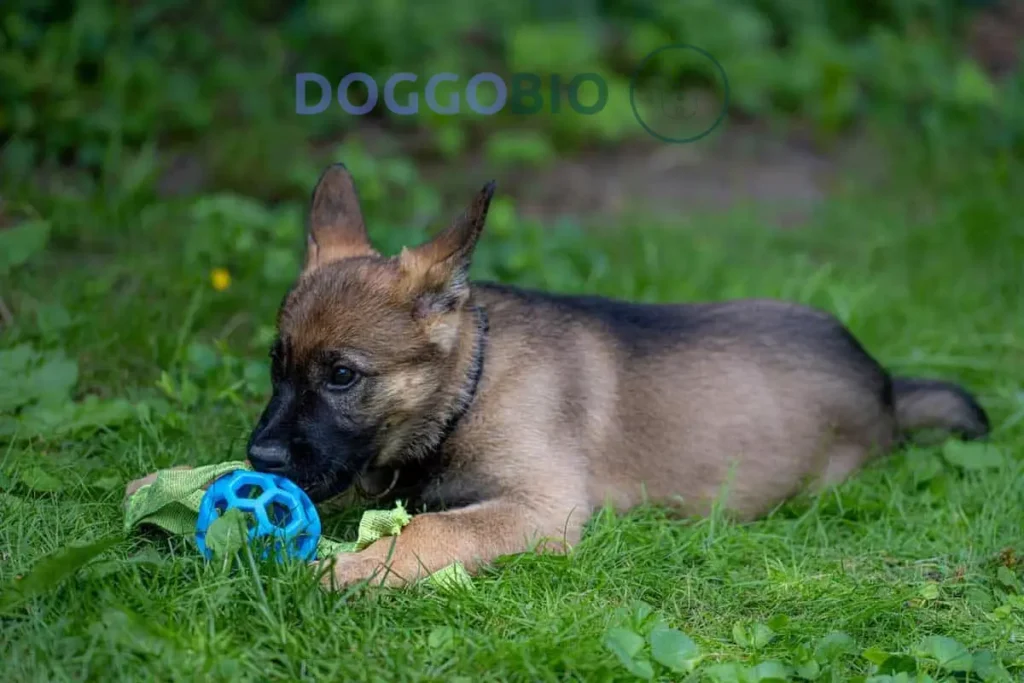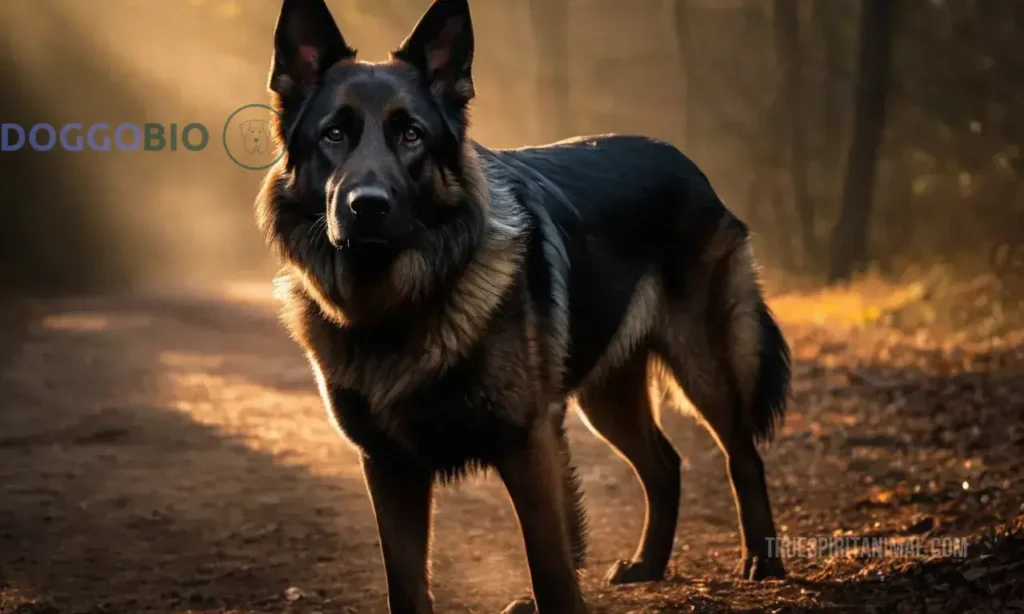The Sable German Shepherd, a breed of dog, stands as a true embodiment of grace and power in the realm of canine beauty and versatility. With its striking appearance and remarkable traits, this unique variant of the German Shepherd breed captivates hearts and commands attention.
The Sable German Shepherd’s rich history, distinct coat pattern, and exceptional capabilities set it apart as a remarkable companion, working partner, and loyal guardian.
Join us as we delve into the captivating world of the Sable German Shepherd, exploring its origins, characteristics, and the remarkable qualities that make it an exceptional and sought-after canine companion.
A Brief Overview of a Sable German Shepherd
| Origin | Germany |
| Coat Type | Double Coat (Medium Length) |
| Temperament | Intelligent, Loyal, Protective |
| Energy Level | High |
| Shedding | Seasonal |
| Barking | Moderate |
| Trainability | Highly Trainable |
| Living Conditions | Ideally Suited for Larger Spaces |
| Special Skills | Guarding, Search and Rescue |
| Common Jobs | Police, Military, Service Work |
| Common Health Issues | Hip and Elbow Dysplasia, Allergies |
| Grooming Needs | Regular Brushing, Bathing as Needed |
| Suitable for Families | Yes, with Proper Training and Socialization |
| Other Varieties | Black and Tan, Bi-color, Solid Black |
What is a Sable German Shepherd?

Sable German Shepherds are a unique color variation within this breed. The term “sable” is commonly used to describe their coloration, not just in the dog world but also in art. While often labeled as “black,” sable is a transitional hue.
The fur’s base or the portion closer to the body showcases a lighter shade, transitioning to a black tone towards the tips. In Sable German Shepherds, this transition often manifests as light brown or gray at the base, gradually darkening to black tips. This descriptor has gained popularity across various dog breeds, capturing this distinctive coat coloration.
History of Sable German Shepherd
The Sable German Shepherd’s history can be traced back to Germany, where it was originally known as the Alsatian Wolf Dog. Bred for herding sheep, it evolved into a highly capable working dog, excelling in roles like search and rescue, police work, and military service due to its strength, intelligence, and trainability.
In the 1850s, Max von Stephanitz played a key role in standardizing dog breeds for specific tasks. He discovered Horand von Grafrath, a sable-colored German Shepherd, in 1899, marking the inception of the Society for German Shepherd Dogs. Through extensive breeding, the breed’s distinct traits were solidified.
The German Shepherd gained popularity in the early 20th century in the United States, particularly among gangsters and bootleggers, thanks to its strength and intelligence. It even had admirers like Adolf Hitler in Nazi Germany. While it earned a reputation for being fierce and imposing, this was often a reflection of its roles rather than its true temperament
What does a Sable German Shepherd look like?
Sable German Shepherds closely resemble their German Shepherd counterparts, with distinct coat coloring. They have a domed head, square muzzle, alert ears, and a long neck, creating an imposing presence. The ideal proportion is longer than tall, with a 10 to 8.5 ratio. Their bushy tail forms a distinctive hook-like shape.
In motion, they lower their heads, resembling prowling wolves, connecting them to their canine ancestors

Size, height, and Weight
As a sizable breed, male sables can grow to around 26 inches in height and weigh between 75 to 95 pounds.
Their female counterparts are slightly more minor, generally at most 24 inches tall and usually weigh between 55 and 75 pounds.
Coat colors and Types
Sable German Shepherds have double coats, typically with a medium or long guard layer. While tan and black or red and black combinations are common in German Shepherds, the primary color is usually a lighter brown with a black face mask and saddle-like markings on the back.
Other color variations include pure black, white, liver, silver, blue, panda, and sable. Sable refers to lighter hair with black tips, creating a gray or mottled appearance. The sable pattern can include tan, black, brown, or red.
In the United States, they’re often called “sable,” while in Germany, they’re commonly known as “grey.”
Temperament and Personality
The color of a German Shepherd doesn’t impact its temperament so a sable one will share the breed’s typical demeanor. Known for being active, intelligent, and eager to please, German Shepherds excel as working dogs. Their loyalty extends to family, fostering protectiveness and vigilance.
While not inherently aggressive, their reputation is linked to their historical roles and bite strength. Early socialization is vital to managing their protective instincts and interactions with strangers and animals. Their natural suspicion of strangers and chasing tendencies can be controlled with proper training. Their intelligence and curiosity also make them apt for search and rescue tasks.
Training and Exercise Requirements
Sable German Shepherds are high-energy dogs, requiring at least 2 hours of daily exercise. Puppies should start extended runs at around 7 months old. They enjoy herding-like activities, such as organizing toys and moving objects. These dogs excel in climbing and swimming, so consider hikes and lakeside adventures. They need both physical and mental stimulation.
Positive reinforcement is key for training these independent and historically pack-oriented dogs. They respond well to a rewarding approach but may show stubbornness, so avoid scolding. Building a bond through positive, patient training is essential, as Sables can be selective about their connections. Early socialization is vital, and their remarkable intelligence adds to their endearing personality.
Grooming and Cleaning
- German Shepherds have double coats that shed consistently, with more significant shedding during 2 seasonal periods. Regular brushing can help manage shedding. Occasional visits to a grooming salon are beneficial for coat maintenance.
- For medium-coated Sable German Shepherds, brushing twice a week may suffice, but those with long hair require daily brushing to prevent knots and tangles. Keep in mind that this breed may not be suitable for allergy sufferers.
- Maintain dental care by brushing their teeth and providing dental chews. Check their erect ears for dust and dirt buildup.
Food and Diet
For the well-being of large dog breeds like the Sable Shepherd, a daily intake of around 1600 calories is essential. However, it’s wise to tread cautiously with treats, reserving them primarily for training, considering potential health issues.
During the puppy phase, opt for smaller, frequent meals—about 3 to 4 times daily—until they mature. As adults, provide your Shepherd with at least 2 servings of high-quality dry kibble daily.
Incorporating wet food into their diet ensures the intake of vital proteins from meat and animal organs, adding an extra layer of nutritional value to your German Shepherd’s meals.
Life Expectancy and Common Health Issues
The average lifespan of German Shepherds hovers slightly over 10 years, aligning with their size—larger breeds often experience shorter lifespans compared to more petite counterparts.
Several common health issues within this breed stem from early inbreeding during its development. Consequently, even sable German Shepherds might not escape these concerns, as producing the sable color often necessitates additional inbreeding.

- Hip and elbow dysplasia, developmental joint abnormalities leading to discomfort, and limited mobility, are prevalent among these dogs. Such issues arise from varying growth rates in different body elements. Adequate nutrition and suitable exercise during vital growth periods serve as preventive measures.
- Even if hip and elbow dysplasia don’t surface in younger dogs, they can render older German Shepherds more prone to arthritis and joint pain. Orthopedic beds prove advantageous for older individuals, relieving joint pressure.
The breed is also susceptible to degenerative myelopathy, a spinal cord degenerative disease typically manifest in dogs around seven or older.
How much is a Sable German Shepherd?

The cost of a Sable German Shepherd puppy typically falls within the range of $800 to $1500. A standard German Shepherd puppy comes at a more affordable price, ranging from $300 to $700.
If these prices don’t align with your budget or adoption is your preference, exploring local shelters could lead to German Shepherds needing a loving forever home!
Is a Sable German Shepherd the Right Dog for You?
Considering adding a Sable German Shepherd, or any German Shepherd, to your family? Here are key factors to assess your compatibility with this breed:
- Dog Experience: German Shepherds are trainable but need confident owners to manage their assertiveness.
- Housing: They require ample outdoor space and a secure yard, not suitable for apartments.
- Active Lifestyle: They thrive on regular exercise and outdoor activities.
- Time Commitment: German Shepherds need companionship and mental stimulation.
Considering these factors will help determine if a German Shepherd, including the sable variety, is a good fit for your family.”
List of dogs that are similar to Sable German Shepherd
Frequently Asked Questions
Are Sable German Shepherds Rare?
Yes, Sable German Shepherds are uncommon compared to the prevalent tan and black or red and black colorations that predominate the breed.
Consequently, acquiring a sable puppy might incur a higher cost than other color variations. It’s worth noting that pure black German Shepherds are even rarer in comparison.
What bad habits do German Shepherds have?
German Shepherds possess a natural tendency towards suspicion, potentially leading to heightened protectiveness and territorial behavior.
Proper socialization can mitigate these tendencies; a hint of this characteristic might persist throughout their lives.
What is the difference between a sable German Shepherd and a German Shepherd?
When comparing Sable German Shepherds to standard GSDs, the primary distinction lies in their coat color. This distinction arises from a dominant gene present in those with sable coats. Apart from this, their temperament and requirements remain consistent with other GSDs!
Do Sable German Shepherds Darken as They Grow?
Yes, Sable German Shepherd puppies tend to undergo a color transformation as they age. The Sable coat typically matures to a deeper hue, often continuing this change until the dog is around 3 years old.
Are Sable German Shepherds hypoallergenic?
No, the Sable German Shepherd is not hypoallergenic. This breed sheds heavily and is not recommended for individuals with dog allergies.
Conclusion
The Sable German Shepherd exemplifies the perfect blend of elegance and strength. Its distinctive coat, rooted in a rich history, reflects its unique character. Beyond its striking appearance, this breed’s intelligence, loyalty, and adaptability make it an exceptional companion and worker.
By caring for and appreciating the Sable German Shepherd, we honor the bond between humans and these remarkable animals, ensuring their legacy shines brightly.

Pingback: Short Haired German Shepherds: Beauty and Bravery 2024
Pingback: Great Pyrenees German Shepherd Mix: Hybrid Harmony 2024